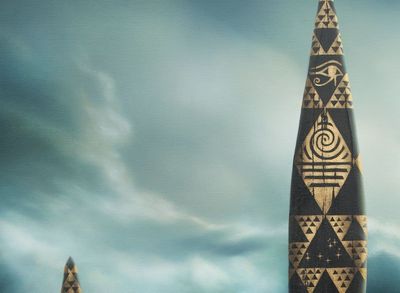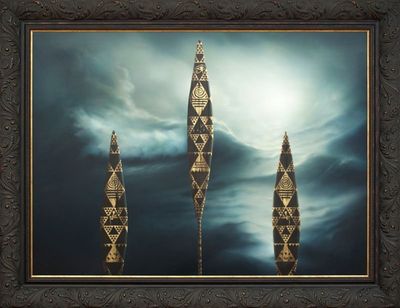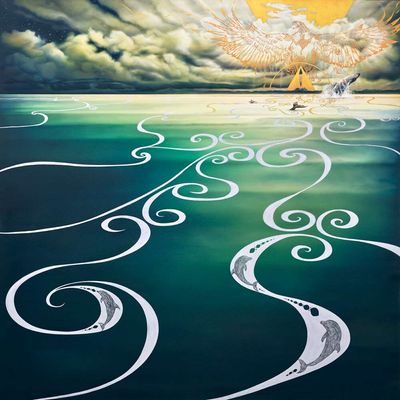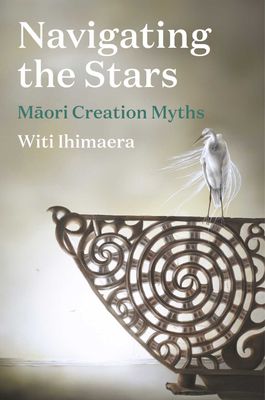



The Navigators
$2,000.00
Explore the story of the artwork >>
Print sizes and editions
- Regular museum archival paper print - 543 x 740mm
(limited to 95) - Large museum archival paper print - 776 x 1057mm
(limited to 95) - Extra Large museum canvas print - 870 x 1180mm
(limited to 95)
Your unique limited edition fine art print
- Sofia Minson creates your exclusive signed print
- We ship for $25 in NZ and from $50 internationally
- Your artwork arrives rolled, ready to be framed - do you need help? Request framing guidance
Original painting SOLD, oil and flashe (acrylic vinyl) on canvas, 1210 x 1570mm (including ornate wooden frame), 2017
The story of The Navigators
"All of us come from a long line of ancestors, of survivors, who navigated undulating oceans of countless lifetimes in their own way. These paddles with Māori and Egyptian symbolism honour our tupuna who migrated across the Pacific, voyaging by the stars."
In this work we see culture and civilisation relentlessly voyage into the wild, untamed realm of nature. This is a very important painting that brings together 13 years of my ideas and techniques.
For the first decade of my career I was painting New Zealand landscapes and seascapes with waka. I was obsessively honing a moody, glowing oil painting technique. For the last three years I've been playing around with new water-based mediums including flashe. My style has incorporated highly detailed patterns and symbols from Pacific and Asian cultures.
In this painting, the two "me's" have met for the first time.
Influences
I love the quality of light and movement in Turner's paintings. I was looking at 19th century works of man crossing the stormy seas. Among them "The Raft of the Medusa" and our own kiwi version by Goldie and Steele called "The Arrival of the Māoris in New Zealand." A sign of its time, The Arrival focusses on imagined physical suffering at sea rather than on accounts of experienced Pacific Navigators.
The Navigators is a communication realm, where we are connected with ancestral gods and the elements.
I was inspired by what we know about the early history of Māori and Pacific people and also, what we don't know.
The Feathered Serpent
Take the Feathered Serpent, which doesn't exist in the natural world. It could not be "naturally assumed" by humans, yet it is encoded in religion, myth and art all around the world. It must have been carried from culture to culture somehow. Just look the Chinese dragon and European dragon. The Meso-American feathered serpent deities Quetzalcoatl, Kulkulcan and Viracocha. And the Egyptian winged serpent who protects the pharaoh during his trip into the afterlife.
I'm wondering, is the Māori bird-headed, lizard-tailed manaia, which I've painted a thousand times, our version of the feathered serpent? The manaia is a messenger between the spirit and mortal worlds. And here in the waka paddles I've morphed it with the Egyptian feathered serpent.
Or am I wrong? Perhaps a winged serpent could be naturally assumed by humans. There is another possibility for it popping up everywhere in the world.
It could be a deep-seated psychological symbol for a "predator being" that indicates "danger" or "the unknown." Think of our shared evolution as a species. Even in isolation we may be drawing out of our unconscious this archetypal "meta" predator. We describe it in our myths and stories. An abstract creature that combines the talons and wings of a bird of prey with a snake's body and the legs and claws of a predatory cat. They are all predatory animals that we would have had to learn to avoid when we were one species living on the planes of Africa. Or how about going back even earlier in our shared evolution. When we were furry rat-like mammals, our psyche was imprinting how to avoid horrendously large predators. And perhaps that information has been emblazoned on our subconscious.
Ancient Egyptians
Ancient Egyptians may have also been navigators. Egyptian hieroglyphs have been found in Australia. Ocean-going ships have been found buried beneath the Giza pyramids. Egyptians knew plenty about advanced mathematics, building techniques and astronomy. And who knows more about astronomy than ocean-going people? Just look at our Polynesian ancestors who navigated by the stars.
So in honour of these voyaging ancestors, I've painted Matariki, the Pleiades constellation. Matariki rises above the horizon in mid-winter signalling the Māori new year.
There are triangular fractal patterns painted in the paddles, found in Māori tukutuku and Taaniko designs. Also on the paddles are double spirals seen in carving. The symbol of the third eye, or eye of horus, symbolising the seat of consciousness, occupies the highest space.
"I see these three waka paddles as being all of our ancestors."
No matter what our whakapapa, we should probably acknowledge those people who somehow traversed the globe and overcame terrific hurdles in their own lives so we could be here, now.
Sofia Minson Paintings | New Zealand Artwork



